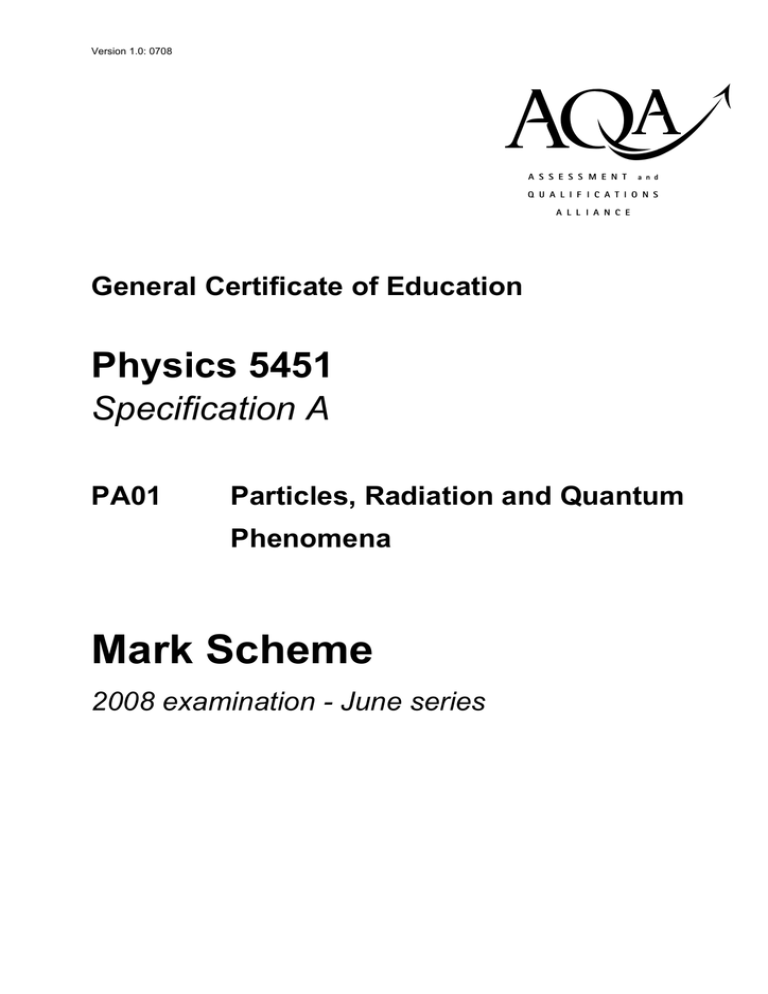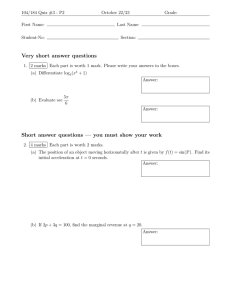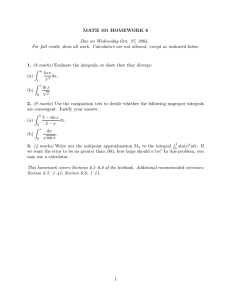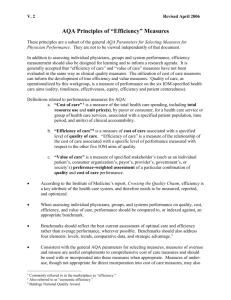
Version 1.0: 0708
abc
General Certificate of Education
Physics 5451
Specification A
PA01
Particles, Radiation and Quantum
Phenomena
Mark Scheme
2008 examination - June series
Mark schemes are prepared by the Principal Examiner and considered, together with the
relevant questions, by a panel of subject teachers. This mark scheme includes any
amendments made at the standardisation meeting attended by all examiners and is the scheme
which was used by them in this examination. The standardisation meeting ensures that the
mark scheme covers the candidates’ responses to questions and that every examiner
understands and applies it in the same correct way. As preparation for the standardisation
meeting each examiner analyses a number of candidates’ scripts: alternative answers not
already covered by the mark scheme are discussed at the meeting and legislated for. If, after
this meeting, examiners encounter unusual answers which have not been discussed at the
meeting they are required to refer these to the Principal Examiner.
It must be stressed that a mark scheme is a working document, in many cases further
developed and expanded on the basis of candidates’ reactions to a particular paper.
Assumptions about future mark schemes on the basis of one year’s document should be
avoided; whilst the guiding principles of assessment remain constant, details will change,
depending on the content of a particular examination paper.
Further copies of this Mark Scheme are available to download from the AQA Website: www.aqa.org.uk
Copyright © 2008 AQA and its licensors. All rights reserved.
COPYRIGHT
AQA retains the copyright on all its publications. However, registered centres for AQA are permitted to copy material
from this booklet for their own internal use, with the following important exception: AQA cannot give permission to
centres to photocopy any material that is acknowledged to a third party even for internal use within the centre.
Set and published by the Assessment and Qualifications Alliance.
The Assessment and Qualifications Alliance (AQA) is a company limited by guarantee registered in England and Wales (company number 3644723) and a registered charity (registered charity number 1073334).
Registered address: AQA, Devas Street, Manchester M15 6EX
Dr Michael Cresswell Director General
Physics A PA01 - AQA GCE Mark Scheme 2008 June series
Instructions to Examiners
1
Give due credit to alternative treatments which are correct. Give marks for what is
correct; do not deduct marks because the attempt falls short of some ideal answer.
Where marks are to be deducted for particular errors specific instructions are given in
the marking scheme.
2
Do not deduct marks for poor written communication. Refer the script to the Awards
meeting if poor presentation forbids a proper assessment. In each paper candidates
may be awarded up to two marks for the Quality of Written Communication in cases of
required explanation or description. Use the following criteria to award marks:
2 marks:
Candidates write legibly with accurate spelling, grammar and punctuation;
the answer containing information that bears some relevance to the
question and being organised clearly and coherently. The vocabulary
should be appropriate to the topic being examined.
1 mark:
Candidates write with reasonably accurate spelling, grammar and
punctuation; the answer containing some information that bears some
relevance to the question and being reasonably well organised. Some of
the vocabulary should be appropriate to the topic being examined.
0 marks:
Candidates who fail to reach the threshold for the award of one mark.
3
An arithmetical error in an answer should be marked AE thus causing the candidate to
lose one mark. The candidate’s incorrect value should be carried through all
subsequent calculations for the question and, if there are no subsequent errors, the
candidate can score all remaining marks (indicated by ticks). These subsequent ticks
should be marked CE (consequential error).
4
With regard to incorrect use of significant figures, normally two, three or four
significant figures will be acceptable. Exceptions to this rule occur if the data in the
question is given to, for example, five significant figures as in values of wavelength or
frequency in questions dealing with the Doppler effect, or in atomic data. In these cases
up to two further significant figures will be acceptable. The maximum penalty for an
error in significant figures is one mark per paper. When the penalty is imposed,
indicate the error in the script by SF and, in addition, write SF opposite the mark for that
question on the front cover of the paper to obviate imposing the penalty more than once
per paper.
5
No penalties should be imposed for incorrect or omitted units at intermediate stages in a
calculation or which are contained in brackets in the marking scheme. Penalties for unit
errors (incorrect or omitted units) are imposed only at the stage when the final answer to
a calculation is considered. The maximum penalty is one mark per question.
6
All other procedures, including the entering of marks, transferring marks to the front
cover and referrals of scripts (other than those mentioned above) will be clarified at the
standardising meeting of examiners.
3
Physics A PA01 - AQA GCE Mark Scheme 2008 June series
GCE Physics, Specification A, PA01, Particles, Radiation and Quantum Phenomena
Question 1
(a)
37 protons; 37 electrons !
2
58 neutrons !
(b)
A = 137 Z = 55 !
(c)
37 × 1.6 × 10-19/95 × 1.67 × 10-27 !
1
2
3.73 × 107 (C kg-1) !
Total
5
Question 2
(a)
(i)
(ii)
(b)
(to have a small collision area) to reduce the uncertainty in the
scattering angle !
2
in order for the α particles to be scattered only once !
maximum 2 from
the maximum number of α particles occur at zero scattering angle
or
in the straight through position !
the minimum number of α particles occur at 180° scattering angle
or
are backscattered along their original path !
max 2
there is a (smooth) decrease in the number of scattered α particles
from 0° to 180° !
(c)
radius of nucleus < radius of atom
or
an atom is mainly an empty space !
as most α particles are undeflected !
or the positive charge of an atom is (concentrated) in the nucleus !
as it provides a strong enough repulsion to cause backscattering of
the α particles !
or the nucleus contains most of the mass of the atom !
for it to be massive enough to backscatter the α particles !
mark any two statements and corresponding reasons
4
4
Physics A PA01 - AQA GCE Mark Scheme 2008 June series
(d)
top
largest bend down with minimum radius of curvature
closest to nucleus !
middle
less bending down with minimum radius of curvature
closest to nucleus !
bottom
even less bending down with minimum radius of
curvature closest to nucleus !
Total
3
11
Question 3
(a)
K 0 = sd !
3
π − = du !
π + = ud !
(b)
baryon
lepton
hadron
charged
K0
×
×
!
×
π-
×
×
!
!
2
one mark for each row !!
(c)
(i)
weak interaction !
(ii)
strangeness is not conserved
or it allows a quark to change its flavour or type !
2
Total
7
Question 4
(i)
moving or accelerated electrons (or reference to current flow) !
collide with orbiting electrons/mercury atoms !
causing the electrons/atoms to jump up energy levels !
(ii)
electromagnetic radiation/photons !
max 7
(mainly) in the ultra violet !
(iii)
to absorb the electromagnetic radiation/photons !
and re-radiate at a lower frequency/longer λ or lower energy !
in the visible region !
Total
5
7
Physics A PA01 - AQA GCE Mark Scheme 2008 June series
Question 5
(a)
(i)
nglass (= sin θair/sin θglass) = sin 45°/sin 29° !
nglass = 1.46 !
(ii)
use of glassngel = ngel/nglass = sin θglass/sin θgel
or
5
n gel
n
sin θc = 2 or
!
n glass
n1
ngel = 1.46 × sin 74°/sin 90° !
ngel = 1.40 !
(b)
TIR from the bottom surface !
with 74° marked !
4
refracting away from the normal from the side of the prism !
emergent ray (horizontal) with angles marked !
v (= c/n) = 3.00 × 108/1.59 (= 1.89 × 108 m/s) !
(c)
2
t (= s/v) = 5.00/1.89 × 108 = 2.65 × 10-8 s ! [2 → 4 sig fig]
Total
11
Question 6
(a)
(b)
(i)
electrons behave like particles and like waves !
(ii)
particles -
(for example) deflection of electrons in an electric or
magnetic field !
waves -
(for example) diffraction of electrons !
(i)
3
v (= h/m λ) = 6.63 × 10-34/9.11 × 10-31 × 1.50 × 10-6 !
= 485 m s-1 !
(iii)
(the momentum of the protons is the same as the electrons to have
the same de Broglie wavelength)
p = 9.11 × 10-31 × 485 = 4.42 × 10-28 kg ms-1 !
4
[or using p = h/λ = 6.63 × 10-34/1.50 × 10-6 = 4.42 × 10-28 kg ms-1 !]
(iii)
(significant) diffraction occurs when the wavelength is of similar size
to the separation !
[or the wavelength is (much) larger than the separation !]
Total
Quality of Written Communication Q2 (a) (b) (c) and/or Q4
6
7
2






